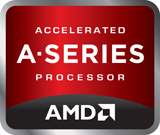
Advanced Micro Devices, Inc. (AMD) is an American multinational semiconductor company based in Santa Clara, California, that develops computer processors and related technologies for business and consumer markets. While it initially manufactured its own processors, the company later outsourced its manufacturing, a practice known as going fabless, after GlobalFoundries was spun off in 2009. AMD's main products include microprocessors, motherboard chipsets, embedded processors, graphics processors, and FPGAs for servers, workstations, personal computers, and embedded system applications.

Sempron has been the marketing name used by AMD for several different budget desktop CPUs, using several different technologies and CPU socket formats. The Sempron replaced the AMD Duron processor and competed against Intel's Celeron series of processors. AMD coined the name from the Latin semper, which means "always", to suggest the Sempron is suitable for "daily use, practical, and part of everyday life". The last Semprons were launched in April 2014. The brand was retired with the launch of the AMD A-Series APUs.
The AMD Family 10h, or K10, is a microprocessor microarchitecture by AMD based on the K8 microarchitecture. Though there were once reports that the K10 had been canceled, the first third-generation Opteron products for servers were launched on September 10, 2007, with the Phenom processors for desktops following and launching on November 11, 2007 as the immediate successors to the K8 series of processors.
The AMD mobile platform is an open platform for laptops from AMD. Though little marketing was done on this platform, it has been competing with the Centrino platform in the segment to gain more marketshare. Each platform has its own specification, catching up the latest technology developments. Since the acquisition of ATI, AMD began to include Mobility Radeon GPUs and AMD chipsets as part of the requirements of the mobile platform; the first of such platforms is the Puma platform.

The AMD Accelerated Processing Unit (APU), formerly known as Fusion, is the marketing term for a series of 64-bit microprocessors from Advanced Micro Devices (AMD), designed to act as a central processing unit (CPU) and graphics processing unit (GPU) on a single die. APUs are general purpose processors that feature integrated graphics processors (IGPs).
AMD Turion is the brand name AMD applies to its x86-64 low-power consumption (mobile) processors codenamed K8L. The Turion 64 and Turion 64 X2/Ultra processors compete with Intel's mobile processors, initially the Pentium M and the Intel Core and Intel Core 2 processors.
The AMD Bulldozer Family 15h is a microprocessor microarchitecture for the FX and Opteron line of processors, developed by AMD for the desktop and server markets. Bulldozer is the codename for this family of microarchitectures. It was released on October 12, 2011, as the successor to the K10 microarchitecture.
The AMD Jaguar Family 16h is a low-power microarchitecture designed by AMD. It is used in APUs succeeding the Bobcat Family microarchitecture in 2013 and being succeeded by AMD's Puma architecture in 2014. It is two-way superscalar and capable of out-of-order execution. It is used in AMD's Semi-Custom Business Unit as a design for custom processors and is used by AMD in four product families: Kabini aimed at notebooks and mini PCs, Temash aimed at tablets, Kyoto aimed at micro-servers, and the G-Series aimed at embedded applications. Both the PlayStation 4 and the Xbox One use chips based on the Jaguar microarchitecture, with more powerful GPUs than AMD sells in its own commercially available Jaguar APUs.
AMD Steamroller Family 15h is a microarchitecture developed by AMD for AMD APUs, which succeeded Piledriver in the beginning of 2014 as the third-generation Bulldozer-based microarchitecture. Steamroller APUs continue to use two-core modules as their predecessors, while aiming at achieving greater levels of parallelism.
AMD Excavator Family 15h is a microarchitecture developed by AMD to succeed Steamroller Family 15h for use in AMD APU processors and normal CPUs. On October 12, 2011, AMD revealed Excavator to be the code name for the fourth-generation Bulldozer-derived core.
The Puma Family 16h is a low-power microarchitecture by AMD for its APUs. It succeeds the Jaguar as a second-generation version, targets the same market, and belongs to the same AMD architecture Family 16h. The Beema line of processors are aimed at low-power notebooks, and Mullins are targeting the tablet sector.
AMD Athlon X4 is a series of budget AMD microprocessors for personal computers. These processors are distinct from A-Series APUs of the same era due to the lack of iGPUs.
Ryzen is a brand of multi-core x86-64 microprocessors designed and marketed by Advanced Micro Devices (AMD) for desktop, mobile, server, and embedded platforms based on the Zen microarchitecture. It consists of central processing units (CPUs) marketed for mainstream, enthusiast, server, and workstation segments and accelerated processing units (APUs) marketed for mainstream and entry-level segments and embedded systems applications.



